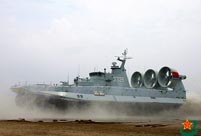

BEIJING, Oct. 31 -- North China has been caught by sudden cold snap with temperatures already sub-zero, but local power plants have been feeling the chill for a long time as soaring coal prices stripped their profits away.
China's five largest power companies saw their combined coal-fired business lose 300 million yuan (45 million U.S. dollars) in September, the first group loss since August 2012.
GD Power Development saw revenue shrink in the first nine months, with net profits down about four percent in the third quarter year on year. Shanghai Electric Power saw its Q3 profit fall by 10.3 percent.
"The high coal price is eating away our profit and there are worries that a short-term shortage might push the price higher," said Liu Shenghan, sales manager of a power company in Shanxi Province, where 30 of 52 coal-fired power plants made losses in the first nine months.
The Bohai-Rim Steam-Coal Price Index, a gauge of coal prices in northern China's major ports, rose to 593 yuan per tonne last week, the 17th consecutive rise and about 60 percent up on the start of the year.
On one hand, the country is cutting excess coal capacity, while on the other, coal prices are edging up. Once synonymous with excess capacity, coal sector is staging a comeback. It is not rare to see trucks waiting in line at coal mines to be loaded, with similar scenes in ports.
Winter is coming, and the coal shortage follows rapid price increases in the past few weeks. The government is in the midst of cutting inefficient production; demand is increasing as the economy stabilizes; and hydroelectric generation is falling as the rainy season ends.
Policymakers face a delicate balancing act and it should be emphasized that the reasons for cutting coal capacity are not exclusively economic; environmental factors play a huge part in current policy.
While rising prices, and profits along with them, might tempt some faltering enterprises to expand production, the policy of cutting overcapacity is not negotiable and a long-term structural overhaul remains the primary objective, according to Sheng Laiyuan of the National Development and Reform Commission (NDRC).
By the end of September, over 80 percent of the 250 million tonnes of capacity up for the chop this year had already been eliminated. Since then the NDRC has called a number of industry-wide meetings, striving to cool price fever while ensuring stable supplies in Q4. At one of those meetings last week, medium-to-long-term supply and price contracts were on the agenda.
These contracts are on the table as a win-win solution; rationalizing the supply chain and securing demand. However, the history of these kinds of contracts is far from ideal. Those for 2014 and 2015 were not well implemented.
For things to work out better this time around, implementation is key and key to implementation is supervision. Third-party credit rating platforms maybe the best option for ensuring that all players fulfill their obligations, industry insiders say.
 Home-made plane completes test flight in Chicago
Home-made plane completes test flight in Chicago The untold stories of women in the Long March
The untold stories of women in the Long March Female soldiers on Frigate Jingzhou
Female soldiers on Frigate Jingzhou Top 10 most beautiful Chinese athletes in Rio
Top 10 most beautiful Chinese athletes in Rio Shenzhen seizes 549 tons of illegally smuggled clothing
Shenzhen seizes 549 tons of illegally smuggled clothing Chinese actor Wang Baoqiang divorces wife, fires manager
Chinese actor Wang Baoqiang divorces wife, fires manager Hangzhou: host city of G20 Summit
Hangzhou: host city of G20 Summit New hovercrafts debut in landing exercise
New hovercrafts debut in landing exercise Woman sets Guinness World Record with 17-month-long pregnancy
Woman sets Guinness World Record with 17-month-long pregnancy Top 10 livable Chinese cities
Top 10 livable Chinese cities Top 20 hottest women in the world in 2014
Top 20 hottest women in the world in 2014 Top 10 hardest languages to learn
Top 10 hardest languages to learn China’s Top 10 Unique Bridges, Highways and Roads
China’s Top 10 Unique Bridges, Highways and Roads Xi as core reassures nation at critical time
Xi as core reassures nation at critical time Chinese aircrafts on display ahead of Zhuhai air show
Chinese aircrafts on display ahead of Zhuhai air show Bicultural couples leave their motherlands to experience life and culture in China
Bicultural couples leave their motherlands to experience life and culture in China Halloween celebrations in China prompt panic over traditional holiday's decline in popularity
Halloween celebrations in China prompt panic over traditional holiday's decline in popularity